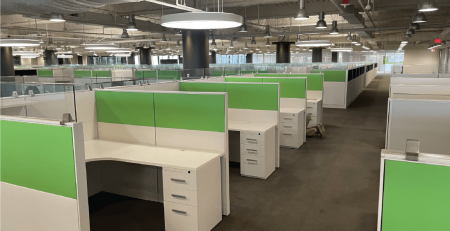The Challenges Faced by Companies in Reusing and Relocating Cubicles: Exploring the Factors Behind the Decision
When companies outgrow their office spaces or undergo relocation, one might wonder why they often choose not to reuse or relocate their existing cubicles. At UsedCubicles.com, we understand that various challenges and factors influence this decision-making process. In this article, we delve into the reasons why many companies opt against reusing or relocating their cubicles, shedding light on the complexities involved and the considerations that drive their choices.
Design Limitations and Space Constraints:
One of the primary reasons companies hesitate to reuse or relocate their cubicles is the issue of design limitations and space constraints. Existing cubicles may not align with the desired aesthetics or layout of the new office space. Each office has unique requirements, and repurposing cubicles to fit a different space can be challenging. Additionally, the configuration of cubicles may not accommodate the evolving needs of the company or the changing nature of work. In such cases, companies often opt for new cubicles that are tailored to their specific spatial and functional requirements.
Cost of Dismantling, Transportation, and Reinstallation:
While reusing or relocating cubicles can be cost-effective in theory, there are practical considerations that companies must account for. The process of dismantling, transporting, and reinstalling cubicles requires specialized expertise, resources, and time. These associated costs, such as labor, transportation, and potential modifications, can sometimes outweigh the perceived savings of reusing cubicles. Companies may prefer to invest in new cubicles to ensure a seamless and efficient office transition, minimizing disruptions and saving valuable time and resources.
Mismatched Aesthetics and Brand Identity:
Maintaining a cohesive and consistent brand identity is crucial for many companies. Reusing cubicles that do not align with the desired aesthetics of the new office space may result in a visual mismatch and disrupt the intended brand image. Businesses often prioritize creating a cohesive and visually appealing workspace that reflects their company culture and values. Opting for new cubicles allows companies to select designs and finishes that align with their brand identity, ensuring a seamless integration within the overall office aesthetics.
Employee Satisfaction and Ergonomics:
Employee satisfaction and well-being are significant considerations when designing office spaces. While reusing cubicles may seem like a cost-effective solution, it may not always meet the ergonomic needs and preferences of employees. Cubicles that were originally designed for different purposes or individuals may not provide the desired level of comfort and functionality. By investing in new cubicles, companies can ensure that the workstations are tailored to support employee productivity, comfort, and overall well-being.
Technological Advancements and Adaptability:
As technology rapidly advances, companies often need to accommodate the integration of new tools and equipment within their workspaces. Older cubicles may not have the necessary infrastructure, cable management systems, or power sources required to support modern technology. Investing in new cubicles allows companies to integrate the latest technological advancements seamlessly and ensure that employees have the necessary resources to carry out their tasks efficiently.
Conclusion:
While reusing or relocating cubicles may appear to be a straightforward solution, companies face various challenges that influence their decision-making process. Design limitations, cost considerations, mismatched aesthetics, employee satisfaction, and technological adaptability all play significant roles in the choice to invest in new cubicles rather than repurpose existing ones. At UsedCubicles.com, we understand the complexities involved and offer a wide range of new and used cubicles to suit the evolving needs of businesses, providing tailored solutions that align with their unique requirements and preferences.











